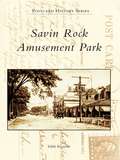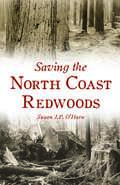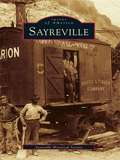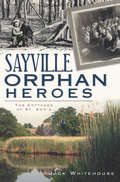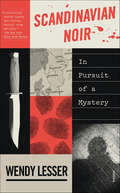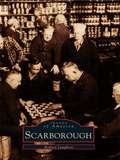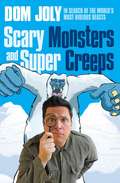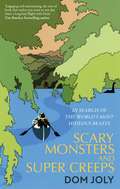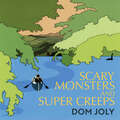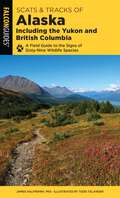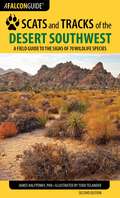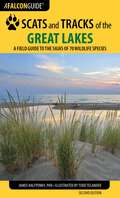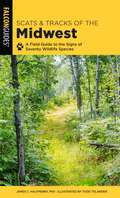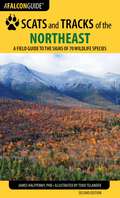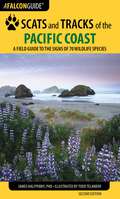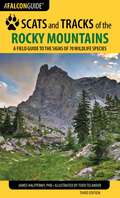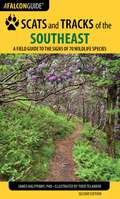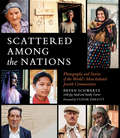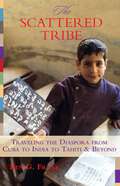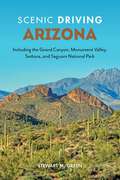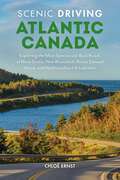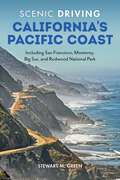- Table View
- List View
Savin Rock Amusement Park (Postcard History Series)
by Edith ReynoldsSavin Rock Amusement Park began to grow in the 1870s when George Kelsey constructed a pier to extend ferry service between the opposite coastlines of New Haven Harbor. This opened the door for further, more sophisticateddevelopment of amusement attractions that drew fun seeking patrons from throughout southern New England. The park thrived until the combination of affordable personal transportation and urban redevelopment forced its demise in the 1960s. Today Savin Rock is a quieter spot fi lled with beachside apartments, a shopping plaza, and a more tranquil grassy park jutting into the harbor. Only a few of the original restaurants remain, changed somewhat from their earlier days but still holding tight to the memories of a different time. Savin Rock Amusement Park contains postcards from the private collection of Ronald P. Guerrera. As an antiques dealer in Waterbury, Guerrera compiled one of the largest and most picturesque collections of postcard memorabilia in Connecticut.
Saving Maine
by Bill Silliker Jr.Is Maine's famed natural character vanishing? The answer is: no, not all of it, thanks to the hard work and generosity of people such as Percival Baxter and Peggy Rockefeller, and of dozens of concerned, ordinary citizens and groups such as the Maine Coast Heritage Trust and The Nature Conservancy, which have helped to establish preserves and parks that will maintain at least some of the natural beauty of Maine forever.
Saving the North Coast Redwoods (Brief History)
by Susan J.P. O'HaraThe battle to preserve a natural wonder.Towering and majestic, the redwood forests of California's North Coast once drew not visitors, but fortune-seeking timber companies. By 1917, the region had been logged for nearly 70 years and concerns arose that the rapidly disappearing redwoods could be lost. Damage wrought by logging and road construction caught the attention of Madison Grant, John Campbell Merriam, and Henry Fairfield Osborn and the Save the Redwoods League was born. Together with the State of California and the U.S. Federal Government, the League's efforts led to the protection of the remaining old growth redwoods, creating state and national parks to preserve them for future generations.Author Susan J.P. O'Hara recounts the story of the fight to save the world's tallest trees.
Sayreville
by Sayreville Historical SocietySayreville is located in Middlesex County on the southern bank of the Raritan River. The area, once known as Roundabout, sits where the river flows into Raritan Bay. The town's recorded history dates to the time when the Rarachon and Navisink tribes of the Lenni Lenape hunted and fished in the area's forests and rivers. Once a part of South Amboy, Sayreville separated and was established as an independent township in 1876. Sayreville's past as a riverfront community is entwined with that of sailing vessels, clay banks, pottery, and brick making. The town quickly became the gateway to America for hundreds of immigrants and their families, who mined the rich clay deposits and labored in the brickyards. At one time, almost every family in town was somehow involved in the brick-making process, as Sayreville became the largest brick-manufacturing center in the United States. During the last century, other industries developed, including the manufacture of clay tile, glass, gunpowder, paints and pigments, nitrocellulose, solvents, photographic and x-ray film, cookies, and crackers.
Sayville Orphan Heroes: The Cottages of St. Ann's
by Jack WhitehouseThe prospects were bleak for the four Whitehouse children in 1929 when they were orphaned at the start of the Great Depression. They faced life in dangerously overcrowded orphanages in New York City or the uncertainty of a trip on the orphan trains. They were fortunate enough to land at the Children's Cottages Orphanage in Sayville, New York and St. Ann's Episcopal Church. Author Jack Whitehouse spins a personal tale of the compassion exhibited by the entire Sayville community, including such families as the Roosevelts and Astors, which allowed the children to thrive. Discover how the town came together to love and nurture these members of the Greatest Generation, who became true American heroes
Scandinavian Noir: In Pursuit of a Mystery
by Wendy Lesser"Even those unmoved by its subject will thrill to [Scandinavian Noir], a beautifully crafted inquiry into fiction, reality, crime and place . . . Perhaps when it comes to fiction and reality, what we need most are critics like Lesser, who can dissect the former with the tools of the latter." --Kate Tuttle, The New York Times Book ReviewAn in-depth and personal exploration of Scandinavian crime fiction as a way into Scandinavian culture at largeFor nearly four decades, Wendy Lesser's primary source of information about three Scandinavian countries—Sweden, Norway, and Denmark—was mystery and crime novels, and the murders committed and solved in their pages. Having never visited the region, Lesser constructed a fictional Scandinavia of her own making, something between a map, a portrait, and a cultural history of a place that both exists and does not exist. Lesser’s Scandinavia is disproportionately populated with police officers, but also with the stuff of everyday life, the likes of which are relayed in great detail in the novels she read: a fully realized world complete with its own traditions, customs, and, of course, people. Over the course of many years, Lesser’s fictional Scandinavia grew more and more solidly visible to her, yet she never had a strong desire to visit the real countries that corresponded to the made-up ones. Until, she writes, “between one day and the next, that no longer seemed sufficient.” It was time to travel to Scandinavia. With vivid storytelling and an astonishing command of the literature, Wendy Lesser’s Scandinavian Noir: In Pursuit of a Mystery illuminates the vast, peculiar world of Scandinavian noir—first as it appears on the page, then as it grows in her mind, and finally, in the summer of 2018, as it exists in reality. Guided by sharp criticism, evocative travel writing, and a whimsical need to discover “the difference between existence and imagination, reality and dream,” Scandinavian Noir is a thrilling and inventive literary adventure from a masterful writer and critic.
Scarborough (Images of America)
by Rodney LaughtonImagine arriving at Scarborough in the late 1800s,stepping out of your train car onto the platform,and becoming one of the many visitors enjoying thesummer beauty of coastal Maine. This pictorial history transports us back to an exciting era in Scarborough's long history--a simpler time, when shore dinner houses and trolley cars were the latest attractions. The images contained in this volume--many of them rare and previously unpublished--feature early automobiles, old homesteads, and summer cottages, as well as unique views of violent shipwrecks and bustling stagecoaches. Through this significant and entertaining collection we experience Prout's Neck the way artist Winslow Homer knew it and everyday life the way that Scarborough photographer Charles F. Walker captured it on film for future generations to marvel at.
Scary Monsters and Super Creeps
by Dom JolyDom Joly sets off round the world again - this time, however, he's not looking to holiday in a danger zone; he's off monster-hunting. Ever since he was given a copy of Arthur C. Clarke's Mysterious World for his ninth birthday, Dom has been obsessed with the world of cryptozoology (monster-hunting), and in Scary Monsters and Supercreeps he heads to four completely different destinations to investigate local monster sightings. He explores the 'Redwood Curtain' in northern California in search of Sasquatch, where he takes a course in Sasquatology at the local university; treks across the Himalayas and joins a Yeti expedition in Bhutan; in Uzbekistan he searches for the Almas, the hairy beast of legend who kidnaps children; and in the forests of Mount Hima in Japan where Hibagon roams he enlists the help of a local man to find the Godzilla-look-alike. In his typical hilarious and irreverent fashion, Dom explores the cultures that gave rise to these monster myths and ends up in some pretty hairy situations, with people even stranger than the monsters they are hunting. Are the monsters all the product of fevered minds, or is there a sliver of truth somewhere in the madness? Either way, it gives Dom an excuse to dive into four fascinating destinations on a gloriously nutty adventure.
Scary Monsters and Super Creeps
by Dom JolyDom Joly sets off round the world again, but this time he's not looking to holiday in a danger zone - he's monster hunting. Ever since he was given a copy of Arthur C. Clarke's Mysterious World for his ninth birthday Dom has been obsessed with the world of cryptozoology (monster hunting), and in Scary Monsters and Super Creeps he heads to six completely different destinations to investigate local monster sightings. He explores the Redwood Curtain in northern California in search of Sasquatch; in Canada he visits Lake Okanagan hoping to catch a glimpse of a thirty-foot snake-like creature called Ogopogo; and near Lake Télé in Congo he risks his life tracking the vegetarian sauropod Mokèlé-mbèmbé. Naturally he heads to Loch Ness - but for this hunt he has his family in tow; he treks across the Khumbu Valley in Nepal looking for Yeti; and in the hills above Hiroshima in Japan he enlists the help of a local man to find the Hibagon, a terribly smelly 'caveman ape'. In typically hilarious and irreverent fashion, Dom explores the cultures that gave rise to these monster myths and ends up in some pretty hairy situations with people even stranger than the monsters they are hunting. Are the monsters all the product of fevered minds, or is there a sliver of truth somewhere in the madness? Either way, the search gives Dom an excuse to dive into six fascinating destinations on a gloriously nutty adventure.
Scary Monsters and Super Creeps: In Search of the World's Most Hideous Beasts
by Dom JolyDom Joly sets off round the world, but this time he's not looking to holiday in a danger zone - he's monster hunting. Ever since he was given a copy of Arthur C. Clarke's Mysterious World for his ninth birthday Dom has been obsessed with the world of cryptozoology - monster hunting - and in Scary Monsters and Super Creeps he heads to six completely different destinations to investigate local monster sightings. He explores the Redwood Curtain in northern California in search of Sasquatch; in Canada he visits Lake Okanagan hoping to catch a glimpse of a thirty-foot snake-like creature called Ogopogo; and near Lake Tele in Congo he risks his life tracking the vegetarian sauropod Mokele-mbembe. Naturally he heads to Loch Ness - but for this hunt he has his family in tow; he treks across the Khumbu Valley in Nepal looking for Yeti; and in the hills above Hiroshima in Japan he enlists the help of a local man to find the Hibagon, a terribly smelly 'caveman ape'. Are the monsters all the product of fevered minds, or is there a sliver of truth somewhere in the madness? Either way, the search gives Dom an excuse to dive into six fascinating destinations on a gloriously nutty adventure. In typically hilarious and irreverent fashion, Dom explores the cultures that gave rise to these monster myths and ends up in some pretty hairy situations with people even stranger than the monsters they are hunting.
Scary Monsters and Super Creeps: In Search of the World's Most Hideous Beasts
by Dom JolyDom Joly sets off round the world, but this time he's not looking to holiday in a danger zone - he's monster hunting. Ever since he was given a copy of Arthur C. Clarke's Mysterious World for his ninth birthday Dom has been obsessed with the world of cryptozoology - monster hunting - and in Scary Monsters and Super Creeps he heads to six completely different destinations to investigate local monster sightings. He explores the Redwood Curtain in northern California in search of Sasquatch; in Canada he visits Lake Okanagan hoping to catch a glimpse of a thirty-foot snake-like creature called Ogopogo; and near Lake Tele in Congo he risks his life tracking the vegetarian sauropod Mokele-mbembe. Naturally he heads to Loch Ness - but for this hunt he has his family in tow; he treks across the Khumbu Valley in Nepal looking for Yeti; and in the hills above Hiroshima in Japan he enlists the help of a local man to find the Hibagon, a terribly smelly 'caveman ape'. Are the monsters all the product of fevered minds, or is there a sliver of truth somewhere in the madness? Either way, the search gives Dom an excuse to dive into six fascinating destinations on a gloriously nutty adventure. In typically hilarious and irreverent fashion, Dom explores the cultures that gave rise to these monster myths and ends up in some pretty hairy situations with people even stranger than the monsters they are hunting.
Scary Monsters and Super Creeps: In Search of the World's Most Hideous Beasts
by Dom JolyDom Joly sets off round the world, but this time he's not looking to holiday in a danger zone - he's monster hunting. Ever since he was given a copy of Arthur C. Clarke's Mysterious World for his ninth birthday Dom has been obsessed with the world of cryptozoology - monster hunting - and in Scary Monsters and Super Creeps he heads to six completely different destinations to investigate local monster sightings. He explores the Redwood Curtain in northern California in search of Sasquatch; in Canada he visits Lake Okanagan hoping to catch a glimpse of a thirty-foot snake-like creature called Ogopogo; and near Lake Tele in Congo he risks his life tracking the vegetarian sauropod Mokele-mbembe. Naturally he heads to Loch Ness - but for this hunt he has his family in tow; he treks across the Khumbu Valley in Nepal looking for Yeti; and in the hills above Hiroshima in Japan he enlists the help of a local man to find the Hibagon, a terribly smelly 'caveman ape'. Are the monsters all the product of fevered minds, or is there a sliver of truth somewhere in the madness? Either way, the search gives Dom an excuse to dive into six fascinating destinations on a gloriously nutty adventure. In typically hilarious and irreverent fashion, Dom explores the cultures that gave rise to these monster myths and ends up in some pretty hairy situations with people even stranger than the monsters they are hunting.
Scats and Tracks of Alaska Including the Yukon and British Columbia: A Field Guide To The Signs Of Sixty-Nine Wildlife Species (Scats and Tracks Series)
by James HalfpennySee those animal signs on the trail? Was that footprint left by a fox or a wolf? Was that pile of droppings deposited by a moose, a mouse, or a marten? Scats and Tracks of Alaska Including the Yukon and British Columbia will help you determine which mammals, birds, reptiles, and amphibians have passed your way and could still be nearby. Clearly written descriptions and illustrations of scats, tracks, and gait patterns will help you recognize species across the entire region. An identification key, a glossary of tracking terms, and detailed instructions on how to document your finds are also included here. Easy-to-use scat and track measurements appear on each page, making this book especially field friendly and letting you know if a white tailed ptarmigan, a red fox, or even a black bear has been your way.
Scats and Tracks of the Desert Southwest: A Field Guide to the Signs of 70 Wildlife Species (Scats and Tracks Series)
by James HalfpennyWhether you're on the lookout for a kit fox, or trying to steer clear of a bear, Scats and Tracks of the Desert Southwest, by nationally reknown tracker and author Dr. James Halfpenny, helps you recognize what critters went before you and is a primer for reading the stories written in the sand. Easy-to-use and accurate scat and track measurements on each page make this book particularly field friendly and the key to starting off your outing on the right foot!
Scats and Tracks of the Great Lakes: A Field Guide to the Signs of 70 Wildlife Species (Scats and Tracks Series)
by James HalfpennySee those animal signs on the trail? Was that footprint left by a fox or a wolf? Was that pile of droppings deposited by a moose, a mouse, or a marten? Scats and Tracks of the Great Lakes will help you determine which mammals, birds, reptiles, and amphibians have passed your way and could still be nearby. Clearly written descriptions and illustrations of scats, tracks, and gait patterns will help you recognize seventy Great Lakes species. An identification key, a glossary of tracking terms, and detailed instructions on how to document your finds are also included here. Easy-to-use scat and track measurements appear on each page, making this book especially field friendly and letting you know if a white tailed ptarmigan, a red fox, or even a black bear has been your way.
Scats and Tracks of the Midwest: A Field Guide to the Signs of Seventy Wildlife Species (Scats and Tracks Series)
by James HalfpennySee those animal signs on the trail? Was that footprint left by a fox or a wolf? Was that pile of droppings deposited by a moose, a mouse, or a marten? Scats and Tracks of the Midwest will help you determine which mammals, birds, reptiles, and amphibians have passed your way and could still be nearby in Iowa, Missouri, Illinois, Indiana, Ohio, and Kentucky. Clearly written descriptions and illustrations of scats, tracks, and gait patterns will help you recognize species across America's heartland. An identification key, a glossary of tracking terms, and detailed instructions on how to document your finds are also included here. Easy-to-use scat and track measurements appear on each page, making this book especially field friendly and letting you know if a white tailed ptarmigan, a red fox, or even a black bear has been your way.
Scats and Tracks of the Northeast: A Field Guide to the Signs of 70 Wildlife Species (Scats and Tracks Series)
by James Bruchac James HalfpennySee those animal signs on the trail? Was that footprint left by a fox or a wolf? Was that pile of droppings deposited by a moose, a mouse, or a marten? Scats and Tracks of the Northeast will help you determine which mammals, birds, reptiles, and amphibians have passed your way and could still be nearby. Clearly written descriptions and illustrations of scats, tracks, and gait patterns will help you recognize seventy Northeast species. An identification key, a glossary of tracking terms, and detailed instructions on how to document your finds are also included here. Easy-to-use scat and track measurements appear on each page, making this book especially field friendly and letting you know if a white tailed ptarmigan, a red fox, or even a black bear has been your way.
Scats and Tracks of the Pacific Coast: A Field Guide to the Signs of 70 Wildlife Species (Scats and Tracks Series)
by James HalfpennySee those animal signs on the trail? Was that footprint left by a fox or a wolf? Was that pile of droppings deposited by a moose, a mouse, or a marten? Scats and Tracks of the Pacific Coast will help you determine which mammals, birds, reptiles, and amphibians have passed your way and could still be nearby. Clearly written descriptions and illustrations of scats, tracks, and gait patterns will help you recognize seventy Pacific Coast species. An identification key, a glossary of tracking terms, and detailed instructions on how to document your finds are also included here. Easy-to-use scat and track measurements appear on each page, making this book especially field friendly and letting you know if a white tailed ptarmigan, a red fox, or even a black bear has been your way.
Scats and Tracks of the Rocky Mountains: A Field Guide to the Signs of 70 Wildlife Species (Scats and Tracks Series)
by James HalfpennySee those animal signs on the trail? Was that footprint left by a fox or a wolf? Was that pile of droppings deposited by a moose, a mouse, or a marten? Scats and Tracks of the Rocky Mountains will help you determine which mammals, birds, reptiles, and amphibians have passed your way and could still be nearby. Clearly written descriptions and illustrations of scats, tracks, and gait patterns will help you recognize seventy Rocky Mountain species. An identification key, a glossary of tracking terms, and detailed instructions on how to document your finds are also included here. Easy-to-use scat and track measurements appear on each page, making this book especially field friendly and letting you know if a white tailed ptarmigan, a red fox, or even a black bear has been your way.
Scats and Tracks of the Southeast: A Field Guide to the Signs of 70 Wildlife Species (Scats and Tracks Series)
by James Bruchac James HalfpennySee those animal signs on the trail? Was that footprint left by a fox or a wolf? Was that pile of droppings deposited by a moose, a mouse, or a marten? Scats and Tracks of the Southeast will help you determine which mammals, birds, reptiles, and amphibians have passed your way and could still be nearby. Clearly written descriptions and illustrations of scats, tracks, and gait patterns will help you recognize Southeast species. An identification key, a glossary of tracking terms, and detailed instructions on how to document your finds are also included here. Easy-to-use scat and track measurements appear on each page, making this book especially field friendly and letting you know if a white tailed ptarmigan, a red fox, or even a black bear has been your way.
Scattered Among the Nations: Photographs and Stories of the World's Most Isolated Jewish Communities
by Bryan Schwartz Jay Sand Sandy Carter“A beautifully presented book on Jewish diversity around the world . . . opens windows into lives from the hills of Portugal to the plains of Africa.” —The Jerusalem PostWith vibrant photographs and intricate accounts Scattered Among the Nations tells the story of the world’s most isolated Jewish communities in Africa, Asia, Latin America, the Former Soviet Union and the margins of Europe. Over two thousand years ago, a shipwreck left seven Jewish couples stranded off India’s Konkan Coast, south of Bombay. Those hardy survivors stayed, built a community, and founded one of the fascinating groups described in this book—the Bene Israel of India’s Maharasthra Province. This story is unique, but it is not unusual. We have all heard the phrase “the lost tribes of Israel,” but never has the truth and wonder of the Diaspora been so lovingly and richly illustrated. To create this amazing chronicle of faith and resilience, the authors visited Jews in thirty countries across five continents, hearing origin stories and family histories that stretch back for millennia.“Beautiful, even breathtaking . . . a Jewish (Inter) National Geographic, wisely reminding us that the strategies for survival of Jews in distant lands may be relevant to our own.” —Rabbi Lawrence Kushner, Emanu-El Scholar at Congregation Emanu-El of San Francisco and author of I’m God; You’re Not“This exquisite book is a gift to the Jewish people, dramatically stretching our understanding of ‘Jewish’ . . . A book to be savored, read and re-read, and transmitted from one generation to the next.” —Yossi Klein Halevi, Senior Fellow, Shalom Hartman Institute, Jerusalem
Scattered Tribe: Traveling the Diaspora from Cuba to India to Tahiti & Beyond
by Ben FrankThis book is an odyssey to discover exotic Jewish communities around the world––a road map of travel and adventure set in such locals as Russia (including Siberia), Tahiti, Vietnam, Myanmar, India, Cuba, Morocco, Algeria, and Israel.
Scenic Driving Arizona: Including the Grand Canyon, Monument Valley, Sedona, and Saguaro National Park (Scenic Driving)
by Stewart M. GreenScenic Driving Arizona features more than thirty drives ranging from 20 to 200 miles long through Arizona's most spectacular landscapes—including the Grand Canyon, Petrified Forest, Monument Valley, and the Sonoran Desert. Included are route maps; in-depth descriptions of special attractions and historical points; and tips on lodging, camping, and dining.
Scenic Driving Atlantic Canada: Exploring the Most Spectacular Back Roads of Nova Scotia, New Brunswick, Prince Edward Island, and Newfoundland & Labrador (Scenic Driving)
by Chloe ErnstScenic Driving Atlantic Canada features nearly thirty separate drives through the beautiful Canadian coastline, from Nova Scotia up to Newfoundland. An indispensable highway companion, Scenic Driving Atlantic Canada includes route maps and in-depth descriptions of attractions.
Scenic Driving California's Pacific Coast: Including San Francisco, Monterey, Big Sur, and Redwood National Park (Scenic Driving)
by Stewart M. GreenThe best way to enjoy California’s spectacular coastline is to drive it! Packed with information about charming seaside communities and featuring all new photographs, this beautiful four-color guide takes you along the 1,100-mile stretch of Highway 1. Whether you’re looking for a short, one-day jaunt or an extended tour of the entire coastline, Scenic Routes & Byways Pacific Coast California shows you the best places in the area to eat, stay, shop, and play.
